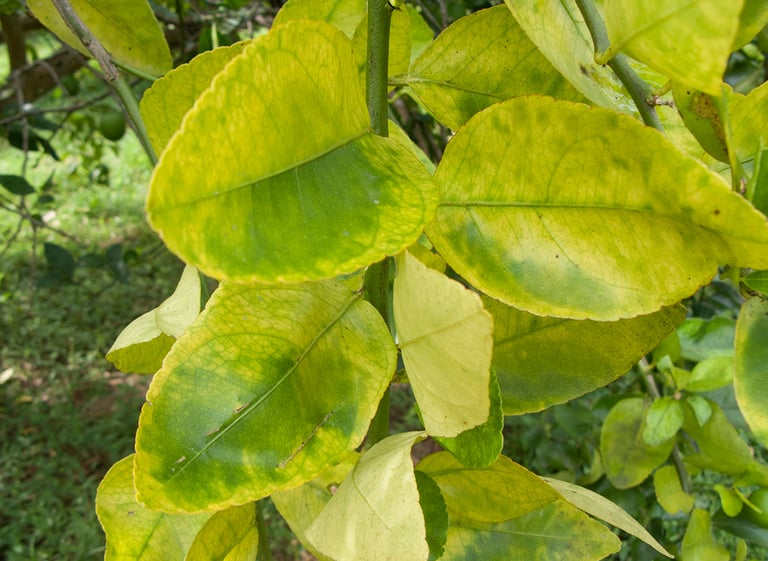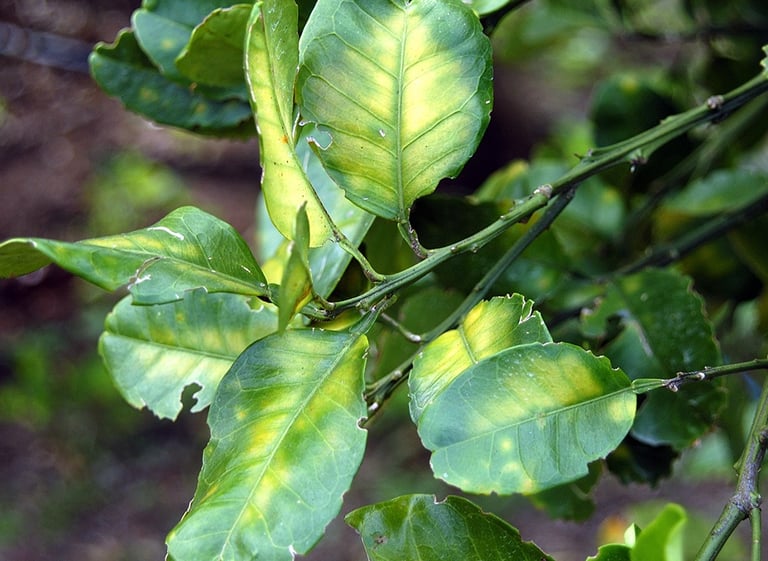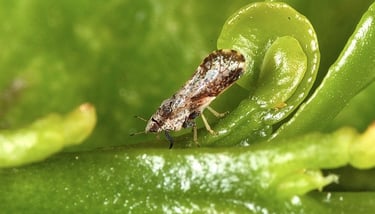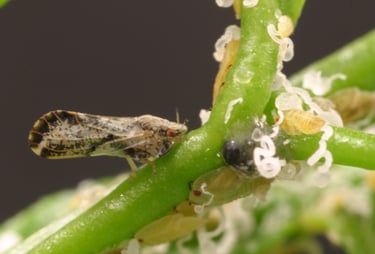Asian citrus psyllid, Diaphorina citri (Kuwayama) (Hemiptera: Psyllidae) & Huang Long Bin (HLB)/ Citrus dieback disease
Asian citrus psyllid is most devastating pest of citrus, that transmits LAS in a persistent manner and, although the rate of LAS transmission by ACP individuals usually is low, HLB can spread rapidly in a citrus grove and the geographic range of the disease is expanding, threatening citrus industries in new areas.
Asian citrus psyllid & huang long bin (HLB)/ citrus dieback The Asian citrus psyllid (ACP), Diaphorina citri Kuwayama (Hemiptera: Psyllidae), is an important pest of citrus because it transmits phloem-limited bacteria [Candidatus Liberibacter spp., notably Candidatus Liberibacter asiaticus (LAS)] associated with huanglongbing (HLB; citrus greening disease), currently considered the world's most serious disease of citrus (McClean & Schwartz, 1970; Bové, 2006). Husain & Nath (1927) presented an early, detailed review of ACP in India, which touched on systematics, distribution, food plants, biology and ecology, behavior, damage, and control. Asian citrus psyllid and HLB have since spread to citrus-growing regions nearly worldwide (Halbert & Manjunath, 2004; Halbert & Núñez, 2004; Pluke et al., 2008), increasing research efforts on ACP and HLB over the past 85 years and expanding our knowledge of the insect, the disease, and their interactions. More recent reviews of ACP or HLB were compiled by Halbert & Manjunath (2004), Bové (2006), Hall (2008a,b, 2010), and Gottwald (2010).
Asian citrus psyllid transmits LAS in a persistent manner and, although the rate of LAS transmission by ACP individuals usually is low, HLB can spread rapidly in a citrus grove and the geographic range of the disease is expanding, threatening citrus industries in new areas. Intensive chemical control of ACP is the primary management strategy currently advocated for HLB, but this strategy is costly, unsustainable, and generally ineffective.
The scientific community is searching aggressively for solutions to HLB on many fronts, but it could still be years before solutions are found and implemented. Plant resistance to LAS is one area of research being pursued.
Geographical distribution and invasion history
The geographical origin of ACP is thought to be southwestern Asia (Halbert & Manjunath, 2004; Beattie et al., 2009). According to Beattie et al. (2009), all evidence concerning the origin of ACP supports that it evolved in India. Asian citrus psyllid reported in China (incl. Hong Kong, Taiwan), India, Myanmar, Philippine Islands, Malaysia, Indonesia, Sri Lanka, Pakistan, Thailand, Nepal, Ryukyu Islands (Japan), Afghanistan, Saudi Arabia, Réunion, and Mauritius (Mead, 1977; Halbert & Manjunath, 2004). Asian citrus psyllid has been in South America since the 1940s, invading Brazil and subsequently Argentina and Venezuela, and it invaded the West Indies (Guadeloupe), Abaco Island, Grand Bahama Island, Cayman Islands, and Florida, USA, in the 1990s (Tsai & Liu, 2000; Halbert & Núñez, 2004). During 2001, ACP was found in the Dominican Republic, Cuba (Halbert & Núñez, 2004), Puerto Rico (Pluke et al., 2008), and Texas, USA (French et al., 2001). Asian citrus psyllid has been reported more recently in many new areas in the Americas, including Mexico, Costa Rico, Belize, Honduras, and the states of Alabama, Arizona, California, Georgia, Louisiana, Mississippi, and South Carolina in the USA [see Halbert et al. (2010) for a recent summary].
Seasonal population dynamics
Seasonal population fluctuations of ACP are correlated closely with the growth of new, young flush on citrus trees because eggs are laid exclusively on young flush and nymphs develop exclusively on young plant parts. Outbreaks can occur any time of year if environmental conditions are favourable and young flush is available (Hall et al., 2008a). Nine generations of ACP were recorded over a 1-year period in India on citrus and it was speculated that two more generations could have developed if more flush had been present during late summer and early fall (Husain & Nath, 1927).
Vector–pathogen interactions
Huanglongbing, associated with three phloem-limited Ca. Liberibacter species in various regions of the world, often spreads quickly in a citrus planting and eventually kills citrus trees, particularly young ones (Xu et al., 1988; Gottwald, 2010). Whereas Ca. Liberibacter africanus and Ca. Liberibacter americanus can cause HLB, and another psyllid, Trioza erytreae (del Guercio), can transmit HLB pathogens, most cases of HLB worldwide currently are related to Ca. Liberibacter asiaticus (LAS) transmitted by ACP (Hall & Gottwald, 2011). The Asian form of HLB is considered to be more severe than the African form (Gottwald, 2007). et al., 1988).
Adult ACP are more highly attracted to LAS-infected trees before feeding on them, but they are more attracted to uninfected trees after feeding on infected ones, which may promote the spread of the pathogen (Mann et al., 2012).
Control of Asian citrus psyllid and huanglongbing
Chemical control
Intensive chemical control programs against ACP have been deemed necessary to combat HLB by growers in many areas across world. However, empirical observations indicate that even intensive insecticide programs against ACP are generally ineffective for preventing the introduction and spread of HLB, especially in new citrus plantings. These observations have been substantiated by research in many geographical areas (Gottwald, 2007) including Florida (DG Hall, unpubl.), Brazil (Berhamin-Filho et al., 2009), and Vietnam (Ichinose et al., 2010). Meanwhile, populations of ACP in Florida are becoming less susceptible to some insecticides (Tiwari et al., 2011).
Frequent and extensive use of pesticides has resulted in severe insecticide resistance in ACP populations.
Biological control agents/Natural enemies
Asian citrus psyllid nymphs commonly are attacked by generalist predators worldwide including ladybeetles (Coleoptera: Coccinellidae), syrphid flies (Diptera: Syrphidae), lacewings (Neuroptera: Chrysopidae, Hemerobiidae), and spiders (Araneae) (Aubert, 1987; Michaud, 2001, 2002, 2004; González et al., 2003). Little is known regarding the extent to which these predators reduce infestations of ACP, but some are considered important biological control agents.
Asian citrus psyllid is attacked by two primary parasitoid species native to Asia: Tamarixia radiata (Waterston) and Diaphorencyrtus aligarhensis (Shafee, Alam & Agarwal). These parasitoids have been introduced in several countries invaded by ACP. Diaphorencyrtus aligarhensis is a solitary endoparasitoid that specializes on ACP and is native to India (Yang et al., 2006).
Unfortunately, biological control by predators and parasitoids usually is not compatible with chemical control nor considered an acceptable management option once a grove is infected by HLB (Halbert & Manjunath, 2004; Yang et al., 2006). Therefore, it is unlikely that traditional biological control by itself will provide a solution to HLB. However, HLB remains a serious problem in most areas where the parasitoid is established including Taiwan, Indonesia, the Philippines, and even in India where T. radiata is native.
Novel Control Program:
Looking at pesticide resistance status and the failure of multiple pesticide molecules to control the population of Asian citrus psyllid, a sustainable containment strategy based on integrated pest management is recommended. During open field trials citrus grove (sweet lime); our combination eBionic® FlyStar plus ATT20-DIA-CIT along with release of biological control agent "Green lacewing" have shown quite promising results. This integrated approach brought down the population of Asian citrus psyllid well below economic threshold level (ETL).


Global Distribution Map: Asian citrus psyllid , Diaphorina citri (Kuwayama) Source: CABI Digital Library








HLB disease affected citrus plants









